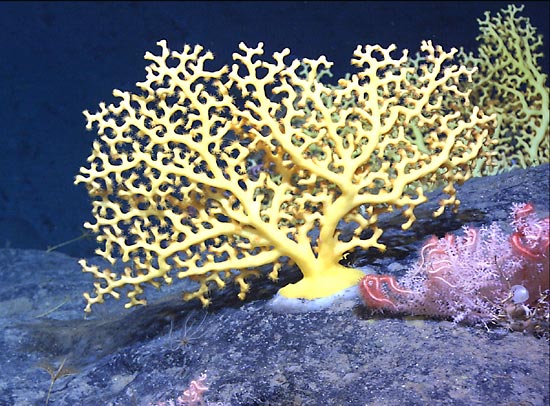Literary Warrant [28]

- President George W. Bush, The White House, Council on Environmental Quality (CEQ), CEQ Fact Sheet: Conserving Our Oceans Through Stewardship, Volunteerism, and Education (March 24, 2008)
"The President And Mrs. Bush Are Committed To Continuing To Protect Our Natural Resources Through Wise Stewardship And Sensible Management. In 2004, the President released his Ocean Action Plan to promote an ethic of responsible use and preservation of our oceans and coastal resources. Of the 88 actions in the President's 2004 Ocean Action Plan, this Administration has met or is on schedule to meet all commitments, and more than a quarter of the existing actions have activities that 'moved beyond' the initial commitments." - Centers for Disease Control (CDC), CDC Influenza Pandemic Operation Plan (January 11, 2008)
"This CDC Influenza Pandemic OPLAN is an INTERNAL document that provides guidance for CDC operations as directed by the Director, Centers for Disease Control and Prevention. This plan is made available to outside agencies for the sole purpose of providing an understanding of the internal processes within CDC. This document in no way prescribes guidance for any entity other than CDC agencies. This plan shall not be construed to alter any law, executive order, rule, regulation, treaty, or international agreement. Noncompliance with this plan shall not be interpreted to create a substantive or procedural basis to challenge agency action or inaction."
- Federal Emergency Management Agency (FEMA), FEMA 2008 Federal Disaster Declarations
Includes tables indicating Declared Disasters by Year or State, Major Disaster Declarations, Emergency Declarations, Fire Management Assistance Declarations, Declaration Policies and Guidance, and a Declaration Process Fact Sheet for Media. - Government Accountability Project (GAP), Climate Change Report Buried by DOT; Author Blocked From Reporters (March 14, 2008)
"This past Wednesday, March 12, the U.S. Department of Transportation (DOT) and the U.S. Climate Change Science Program quietly released a major assessment report on the likely impacts of global climate disruption on a wide range of transportation infrastructure in the Gulf Coast region. This report release was buried by the DOT, and officials have been blocking journalists from speaking with the report’s lead author.
"Specifically the report, Impacts of Climate Change and Variability on Transportation Systems and Infrastructure: Gulf Coast Study, analyzes how Gulf Coast roads and highways, transit services, oil and gas pipelines, freight handling ports, transcontinental railroad networks, waterway systems, and airports are likely to be harmed by heat waves, extreme precipitation events, sea level rise, increased hurricane intensity, and storm surge damage associated with climate change. The report outlines why changes must be incorporated in transportation planning now in order to avoid serious future problems."
- Institutional Investors Group on Climate Change (IIGCC), Electric Utilities: Global Climate Disclosure Frameworks (2008)
"Climate change is increasingly recognised as a key strategic issue for the electricity generation sector. Of all sectors the Electric Utilities1 is the most carbon intensive, responsible for approximately one quarter of all carbon emissions. The opportunities and compulsion for carbon reduction and adaptation strategies for this sector are therefore considerable and warrant particular attention from investors."—Introduction. - Investor Network on Climate Risk (INCR), a project of Ceres, Investor Network on Climate Risk Action Plan—Capitalizing the New Energy Future: Minimizing Climate Risks, Seizing Opportunities (February 2008)
"Nearly 50 leading U.S. and European institutional investors managing over $1.75 trillion in assets today released a climate change action plan at the United Nations that will boost investments in energy efficiency and clean energy technologies and require tougher scrutiny of carbon-intensive investments that may pose long-term financial risks. Additionally, European investors managing $6.5 trillion in assets supported the action plan 'in principle.'"—Press release (February 14, 2008) - Public Employees for Environmental Responsibility (PEER), Dropping the Ball: EPA’s Investigation and Regulation of Pharmaceuticals and Personal Care Products (PPCPs) and Endocrine Disrupting Compounds (EDCs) (March 19, 2008)
"Scientists have known about the widespread presence of chemicals from pesticides, pharmaceuticals and personal care products in our drinking water for decades, despite recent media coverage of the issue. In 1996, Congress ordered the U.S. Environmental Protection Agency (EPA) to address the issue, but the agency has missed deadlines and avoided addressing the growing contamination, according to an analysis released today by Public Employees for Environmental Responsibility (PEER)."—Press release. - James Randerson, Science Correspondent, Scientists warn of soot effect on climate, The Guardian (March 24, 2008)
"Soot produced by burning coal, diesel, wood and dung causes significantly more damage to the environment than previously thought, according to research published today. So-called 'black carbon' could cause up to 60% of the current warming effect of carbon dioxide, according to the US researchers, making it an important target for efforts to slow global warming." - UN Pulse, Addressing Climate Change: The United Nations and the World at Work (February 11, 2008)
"The United Nations General Assembly President has convened this morning a two-day thematic debate entitled Addressing Climate Change: The United Nations and the World at Work. The debate is being guided by the report of the Secretary-General (A/62/644), which provides an overview of the UN's work on climate change." - UN Pulse, Mobilizing Finance for the Climate Challenge (February 13, 2008)
"More than 100 ministers from across the globe are scheduled to attend the Global Ministerial Environment Forum (GMEF)—the world's forum for environment ministers—alongside senior figures from industry and economics; science; local government; civil society, trades unions and intergovernmental bodies."—Press release (February 11, 2008) - UN Pulse, Shared Natural Resources: Aquifers (March 19, 2008)
"The fifth report on shared natural resources of Special Rapporteur Chusei Yamada, on Transboundary Aquifers, has been issued (A/CN.4/591). The report is submitted for the consideration of the International Law Commission and presents draft articles on transboundary aquifers for consideration. Learn more about the ILC's consideration from the online chapter on shared natural resources of the Analytical Guide." - United States Chemical Safety and Hazard Investigation Board (CSB), Anatomy of a Disaster: Explosion at BP Texas City Refinery (2008)
"Three years after the explosion that killed 15 workers and injured 180 others at the BP Texas City refinery, the U.S. Chemical Safety Board (CSB) today released a new, comprehensive safety video that describes the causes of the accident and key safety lessons."—Press release (March 21, 2008) - United States Congress, Congressional Budget Office (CBO), Policy Options for Reducing CO
2 Emissions (Pub. No. 2930) (February 2008)
"The most efficient approaches to reducing emissions of CO2 involve giving businesses and households an economic incentive for such reductions. Such an incentive could be provided in various ways, including a tax on emissions, a cap on the total annual level of emissions combined with a system of tradable emission allowances, or a modified cap-and-trade program that includes features to constrain the cost of emission reductions that would be undertaken in an effort to meet the cap. This Congressional Budget Office (CBO) study—prepared at the request of the Chairman of the Senate Committee on Energy and Natural Resources—compares those policy options on the basis of three key criteria: their potential to reduce emissions efficiently, to be implemented with relatively low administrative costs, and to create incentives for emission reductions that are consistent with incentives in other countries. In keeping with CBO’s mandate to provide objective, impartial analysis, the report contains no recommendations."—Preface. - United States Department of Commerce & National Oceanic and Atmospheric Administration (NOAA), Report to Congress on the Implementation of the Deep Sea Coral Research and Technology Program (March 2008)
 "The Magnuson-Stevens Fishery Conservation and Management Reauthorization Act of 2006 (MSRA) includes a requirement to establish the 'Deep Sea Coral Research and Technology Program.' Section 408 (b) of the reauthorized Act tasked NOAA with submitting, in consultation with the Fishery Management Councils, 'biennial reports to Congress and the public on steps taken by the Secretary to identify, monitor, and protect deep sea coral areas, including summaries of the results of mapping, research and data collection performed under the program.' This is the first biennial report in fulfillment of that requirement."—Executive Summary.
"The Magnuson-Stevens Fishery Conservation and Management Reauthorization Act of 2006 (MSRA) includes a requirement to establish the 'Deep Sea Coral Research and Technology Program.' Section 408 (b) of the reauthorized Act tasked NOAA with submitting, in consultation with the Fishery Management Councils, 'biennial reports to Congress and the public on steps taken by the Secretary to identify, monitor, and protect deep sea coral areas, including summaries of the results of mapping, research and data collection performed under the program.' This is the first biennial report in fulfillment of that requirement."—Executive Summary. - United States Department of Energy (DOE), Climate VISION (Voluntary Innovative Sector Initiatives: Opportunities Now), Climate VISION Progress Report 2007 (February 2008)
"The U.S. Department of Energy (DOE) today released the Climate VISION Progress Report 2007, which reports on the actions taken by energy-intensive industries to improve greenhouse gas emissions intensity of their operations from 2002 to 2006. The report indicates that the power and energy-intensive industrial sectors improved their combined emissions intensity by 9.4 percent over this four year period, and in 2006, actual greenhouse gas emissions for these sectors fell a combined 1.4 percent."—Press release (February 11, 2008) - United States Department of Energy (DOE) & United States Environmental Protection Agency (EPA), National Data Center Energy Efficiency Information Program (March 19, 2008)
"The voluntary National Data Center Energy Efficiency Information Program has been initiated. The Program coordinates a wide variety of activities from the DOE Industrial Technologies Program Save Energy Now initiative, the DOE Federal Energy Management Program (FEMP), and the EPA ENERGY STAR program. The program is engaging numerous industry stakeholders who are developing and deploying a variety of tools and informational resources to assist data center operators in their efforts to reduce energy consumption in their facilities. These groups include, for example: 7 x 24 Exchange, AFCOM, American Society of Heating, Refrigeration and Air Conditioning Engineers (ASHRAE), Critical Facilities Roundtable, Information Technology Industry Council (ITIC), Silicon Valley Leadership Group, The Green Grid Association, and The Uptime Institute."—Summary. - United States Environmental Protection Agency (EPA), Good Neighbor Environmental Board to the President and Congress of the United States (GNEB), (March 2008)
"The border region provides a compelling example of vulnerable populations often not prepared for natural disasters. Unlike the situation in many such emergencies, residents with different cultures, backgrounds and languages must attempt to coordinate their responses across the border, often through informal channels."—Press release (March 19, 2008) - United States Government, Federal Guidance to Assist States in Improving State-Level Pandemic Influenza Operating Plans (March 11, 2008)
"Effective State, local and community functioning during and following an influenza pandemic requires focused planning and practicing in advance of the pandemic to ensure that States can maintain their critical functions. The Interim Pre-pandemic Planning Guidance: Community Strategy for Pandemic Influenza Mitigation in the United States – Early, Targeted, Layered Use of Nonpharmaceutical Interventions (February 2007) was developed to provide guidance for pandemic planning and response. For community mitigation strategies to be effective, State governments need to incorporate them into their operating plans and assist local communities, businesses, non-governmental organizations, and the public in doing the same. State governments must have robust operating plans that have been sufficiently tested and improved by staff who understand and perform proficiently their supporting activities. Community partners must also perform proficiently their roles and responsibilities and understand accurately what the State government will and won’t do and how it will communicate with both them and the public.
"This document provides a strategic framework to help the 50 States, the District of Columbia (DC), and the five U.S. Territories improve and maintain their operating plans for responding to and sustaining functionality during an influenza pandemic."
- United States House of Representatives, Committee on Energy & Commerce, Subcommittee on Energy & Air Quality, Climate Change Legislation Design White Paper: Competitiveness Concerns/Engaging Developing Countries (January 2008)
"The Committee on Energy and Commerce and its Subcommittee on Energy and Air Quality are issuing a series of Climate Change Legislation Design White Papers as the next step toward enactment of a mandatory, economy-wide climate change program. This White Paper released today discusses potential domestic legislative provisions that could encourage developing countries to curb their emissions of greenhouse gases." - Yale Center for Environmental Law and Policy, Yale University & Center for International Earth Science Information Network, Columbia University, Environmental Performance Index 2008 (EPI)
"The 2008 EPI, released at the World Economic Forum in Davos ranks 149 countries on 25 indicators tracked across six established policy categories: Environmental Health, Air Pollution, Water Resources, Biodiversity and Habitat, Productive Natural Resources, and Climate Change. The EPI identifies broadly-accepted targets for environmental performance and measures how close each country comes to these goals. As a quantitative gauge of pollution control and natural resource management results, the Index provides a powerful tool for improving policymaking and shifting environmental decisionmaking onto firmer analytic foundations."—Press release (January 23, 2008)


 Gell-Mann, along with
Gell-Mann, along with 













 This study may also explain why humans talk by gesture and by voice, but chimps talk only with their hands. "In its most specialized way, spoken language is the ability to control the learned movements of our larynx," senior author Erich Jarvis told Science Daily. "It's possible that human language pathways have also evolved in ways similar to these birds. Perhaps the evolution of vocal learning brain areas for birds and humans exploited a universal motor system that predates the split from the common ancestor of birds and mammals."
This study may also explain why humans talk by gesture and by voice, but chimps talk only with their hands. "In its most specialized way, spoken language is the ability to control the learned movements of our larynx," senior author Erich Jarvis told Science Daily. "It's possible that human language pathways have also evolved in ways similar to these birds. Perhaps the evolution of vocal learning brain areas for birds and humans exploited a universal motor system that predates the split from the common ancestor of birds and mammals."






 From his terrace, the world is blue and green — mountains and trees — or almost green. Spring is on the way; the geese are back. One, then two, alight on the river, with more still invisible but close behind. Pavilion living! The only way. With the city somewhere down there, and nature everywhere up here, he watches mist rise. River meets sky.
From his terrace, the world is blue and green — mountains and trees — or almost green. Spring is on the way; the geese are back. One, then two, alight on the river, with more still invisible but close behind. Pavilion living! The only way. With the city somewhere down there, and nature everywhere up here, he watches mist rise. River meets sky.





 Click here or on the picture at right to read the rest of this post . . . .
Click here or on the picture at right to read the rest of this post . . . .












